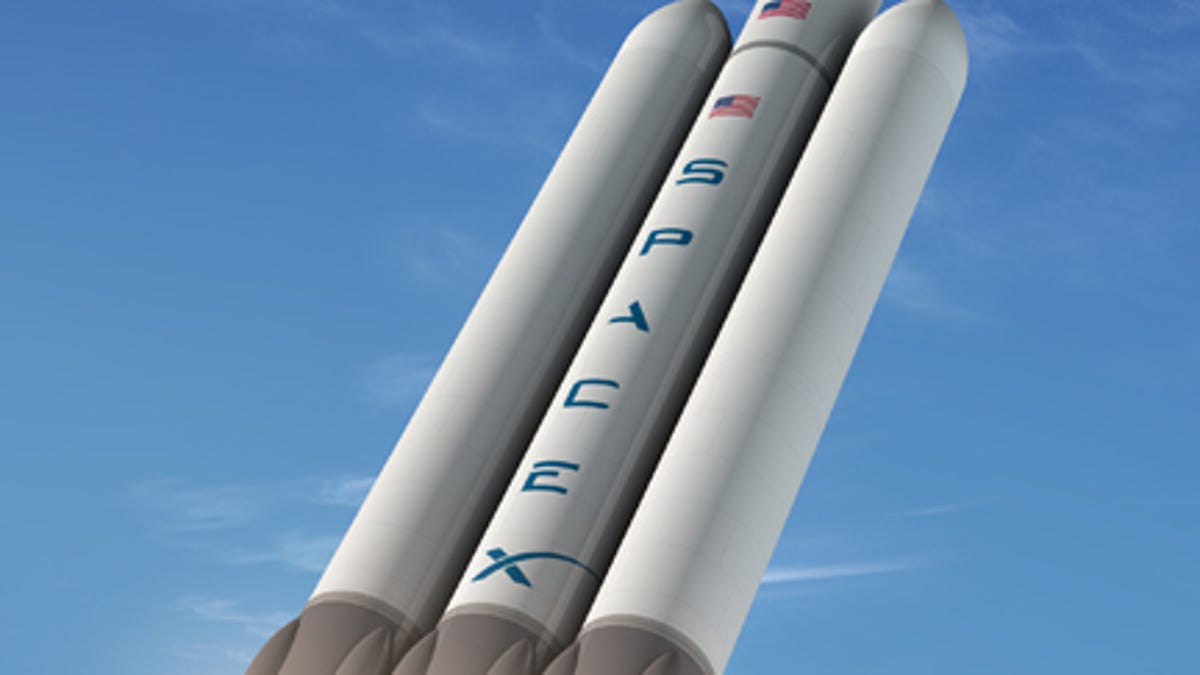SpaceX breaks ground on Falcon Heavy launch site
Company says the launch site will be at the Vandenberg Air Force Base. The company hopes to have the Falcon Heavy at the site by the end of 2012.

The Falcon Heavy rocket from SpaceX will soon have a launch site.
The company--better known as SpaceX than by its official name, Space Exploration Technologies--announced earlier this week that it has broken ground in Southern California at the Vandenberg Air Force Base, which is a Department of Defense space launch and missile testing site.
SpaceX has high hopes for the Falcon Heavy, which will be used by NASA to bring cargo to the International Space Station.The rocket is the first to break the $1,000-per-pound-to-orbit barrier, a feat that many in the space industry thought wouldn't happen for quite some time.
According to SpaceX, each of the Falcon Heavy's engines can generate thrust of 140,000 pounds at sea level and send 117,000 pounds of payload into a 120-mile-high orbit. The rocket itself is 227 feet tall and tips the scales at 3.1 million pounds. It's comprised of three Falcon 9 rockets, developed by SpaceX.
The Falcon Heavy and Falcon 9, alongside Delta 4 rockets from United Launch Alliance, an organization formed by Lockheed Martin and Boeing, represent the future of space missions in the United States. When Atlantis blasted off earlier this month, it marked an end of an era for NASA's space shuttle program.
"After the wheels have stopped and the displays go blank and the orbiter is unpowered for the final time...there will be a rush of emotion when we all finally realize that's it, that it's all over, the crowning jewel of our space program, the way we got back and forth from low-Earth orbit for 30 years...we'll realize that's all over," shuttle commander Christopher Ferguson said last week. "That's going to take a little while to deal with it."
The end of the shuttle missions means U.S. astronauts over the next several years will need to hitch rides to the International Space Station on Russia's Soyuz spacecrafts. According to NASA, those trips will cost the U.S. $60 million per seat.
However, President Obama believes good times are ahead for the U.S. in space, thanks to "groundbreaking research and innovative companies." Speaking at the Kennedy Space Center last year, the president said that over the next couple decades, astronauts will be able to explore where no person has gone before.
"Early in the next decade, a set of crewed flights will test and prove the systems required for exploration beyond low-Earth orbit," Obama said during his address. "And by 2025, we expect new spacecraft designed for long journeys to allow us to begin the first-ever crewed missions beyond the moon into deep space.
"We'll start by sending astronauts to an asteroid for the first time in history," he continued. "By the mid-2030s, I believe we can send humans to orbit Mars and return them safely to Earth. And a landing on Mars will follow. And I expect to be around to see it."
The Falcon Heavy can certainly help the U.S. achieve that goal. According to SpaceX CEO Elon Musk, the rocket can explore deep space and can send people to the moon.
The Falcon Heavy is scheduled to be brought to its launch site by the end of 2012. SpaceX plans to launch a test flight soon after.

